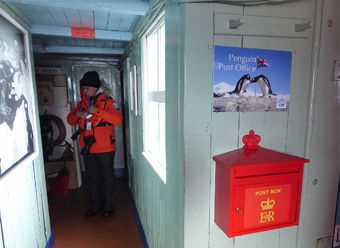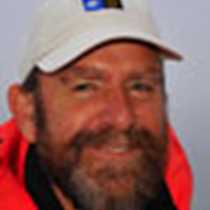Our first hint of the new day came from Russ, our expedition leader, announcing our entry into the legendary Lemaire Channel at 5:30 a.m. Once known as Kodak Alley for its spectacular scenery, today it was cloaked in low clouds and mist, fifty shades of grey. Once out into the Gerlache Strait we veered north towards Anvers Island and were soon anchored in the sheltered bay of Port Lockroy, home to one of the most popular historical gems of Antarctica.
In 1944 the British set up Base A here, a secret location to forestall Argentinian claims to the area and keep tabs on German naval activity in the South Atlantic. Despite these sinister origins, it quickly became a center of scientific research, recording meteorological and ionospheric data. This research played a key part in the discovery of the hole in the ozone layer, but after many active decades, the base was decommissioned in 1962. Thirty years later it still contained much of the original supplies and equipment, but the roof had collapsed and snow filled the rooms. So in 1996 a British Antarctic Survey project began restoring it to its former glory. It is now manned seasonally by the Antarctic Heritage Trust, displaying skis, tools, tins of food, photographs, magazines and pin-up paintings from the 50s, plus (to great excitement from our guests!) a shop and a post office that mails over 70,000 postcards a year to over 120 countries. No wonder it is popular!
We landed on granite rocks that still bear the mooring chains of old whaling ships, to be met by the quizzical locals: fluffy gentoo penguin chicks who followed us, pecking at walking sticks and camera straps. At the ramp up to the buildings, one fat chick lay sprawled across the boot brush board, oblivious to the traffic. In no time the shop was a retail scrum, eager customers buying Lockroy cards and stamps, before posting them at the red postbox on the door. The Union Jack still flies over this tiny remnant of the British Empire.
After lunch we steamed north to Wilhelmina Bay and were soon surrounded by happy humpbacks gorging themselves on krill. Females were teaching their calves how to corral and lunge for a bigger mouthful. Some groups combined to drive the krill into denser targets. The sea seemed alive with waving flippers, slicing flukes, and gaping maws bursting out of the water. But most remarkable of all, two individuals, clearly replete with food, drifted across to one of our Zodiacs and kept spyhopping right off the stern. They refused to leave their new playmate, rolling provocatively close by the boat, giving flipper and fluke salutes, even emerging together like Loch Ness monsters; it seemed as if they were making faces just for the camera. As Herman Melville wrote of them: “the most gamesome and light-hearted of whales.







